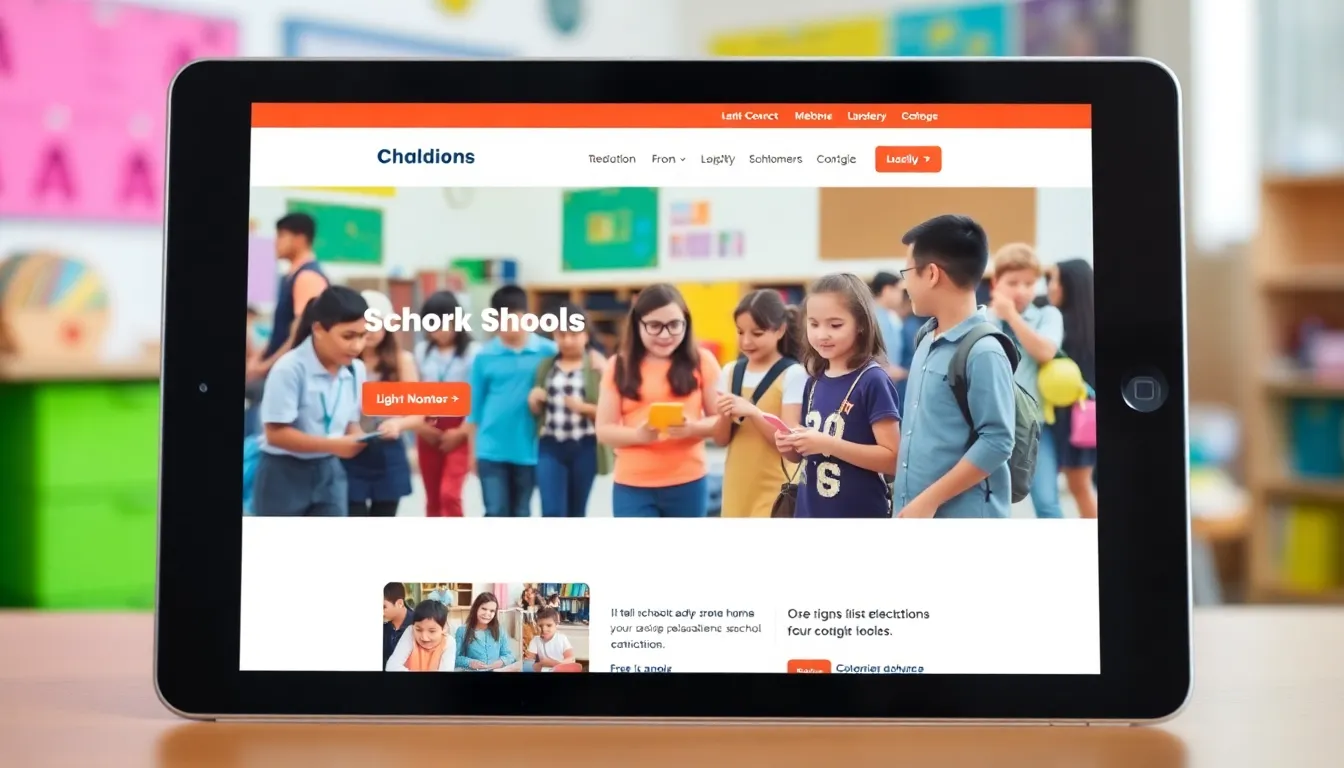In today’s digital age, elementary school websites are more than just online brochures; they’re the virtual front doors to a world of learning and community. Picture this: a colorful, engaging site that not only showcases school spirit but also provides parents with essential information faster than a kid can down a juice box.
These websites are the unsung heroes of education, bridging the gap between teachers, students, and parents. They’re not just for posting lunch menus; they’re dynamic platforms that can inspire involvement, spark curiosity, and even make the principal’s weekly newsletter feel like a page-turner. With the right design and content, a school website can transform from a dusty archive into a vibrant hub of activity. So let’s dive into what makes these digital spaces tick and how they can elevate the elementary school experience for everyone involved.
Table of Contents
ToggleOverview Of Elementary School Websites
Elementary school websites serve multiple purposes beyond merely providing information. They act as dynamic hubs for communication between schools, parents, and students. Engaging visuals and user-friendly designs significantly enhance the user experience. These websites feature important updates, school events, and resources to support student learning.
Parents rely on these sites for timely announcements and essential school-related information. Easy navigation enables quick access to resources, such as lunch menus, class schedules, and teacher contact details. When sites reflect the vibrancy of school spirit, they entice community engagement and foster belonging among families.
Several elements contribute to an effective elementary school website. High-quality images of school events and student work draw visitors in and promote active participation. Integrating social media links allows for efficient channels of communication, while newsletters and blog sections keep the community informed and engaged.
They also play a crucial role in showcasing school achievements and fostering transparency. Listening to feedback from parents and students enhances the site’s effectiveness and relevance. Features such as event calendars, volunteer opportunities, and educational resources support an active school community as well.
Maintaining updated content is vital, ensuring that families remain informed about all developments at the school. Prioritizing responsive design allows for an optimal experience across devices, accommodating parents’ varied preferences for accessing information. Elementary school websites are essential tools that enhance communication, celebrate achievements, and strengthen community ties.
Key Features Of Effective Elementary School Websites

Effective elementary school websites prioritize user experience and community engagement through well-considered features.
User-Friendly Navigation
Navigating a school website remains intuitive and straightforward. Clear menus categorize essential information like class schedules, lunch menus, and event announcements. Users find links to popular resources readily accessible. A search function can further enhance usability, allowing quick access to specific content. Simple layouts enable parents, students, and staff to locate information without confusion. Efficient organization saves time, making it easier for families to stay informed and involved.
Engaging Visual Design
Visual appeal plays a crucial role in drawing users to school websites. High-quality images of school events and activities showcase student involvement and foster school pride. Bright colors and engaging graphics can create a welcoming atmosphere. Incorporating videos in highlights or announcements enhances understanding and keeps the community engaged. Consistent branding reflects the school’s identity and resonates with families. Creative design elements can make the information more inviting and memorable.
Mobile Responsiveness
Today, many users access school websites via mobile devices. Responsive design ensures a seamless experience across smartphones and tablets. Websites that automatically adjust to different screen sizes enhance accessibility. Parents appreciate having important updates and resources at their fingertips. Focused layouts promote easy readability and navigation on smaller screens. A mobile-friendly approach allows families to stay connected anytime, anywhere.
Importance Of Content On Elementary School Websites
Elementary school websites play a crucial role in disseminating information and resources to the school community. Effective content enhances communication between families, students, and staff.
Relevant Information For Parents
Timely announcements and essential updates keep parents informed about school events and policies. Resources like lunch menus and class schedules are easily accessible, allowing for quick planning. Detailed information regarding school programs helps families engage with their child’s education. Prioritizing user-friendly navigation enhances the overall experience, making it simple for parents to find information. Feedback channels provide opportunities for parents to voice concerns or suggestions, fostering a collaborative environment. Engaging visuals paired with clear text create an inviting atmosphere, reflecting the school’s spirit and commitment to its community.
Resources For Students
Engaging content on elementary school websites directly benefits students by promoting learning and involvement. Educational resources, such as homework help and study tips, support academic success. Interactive features, like quizzes or games, foster a fun learning environment outside the classroom. Event calendars keep students informed about extracurricular activities and upcoming school events, encouraging participation. Visual and multimedia materials enhance comprehension and retention of information. Well-structured content presents opportunities for skill-building and personal growth. Prioritized updates on school achievements motivate students to strive for excellence, creating a positive school culture.
Best Practices For Maintaining Elementary School Websites
Maintaining an effective elementary school website involves consistent updates and careful consideration of accessibility. Adhering to best practices ensures these sites remain valuable resources for the community.
Regular Updates And Content Refresh
Regular updates keep information accurate and relevant. Announcements regarding school events or policy changes should appear promptly to guarantee parents stay informed. Schools should also refresh content seasonally, showcasing current student achievements or recent activities. Engaging blog posts can highlight innovative teaching methods or educational strategies. Utilizing a content calendar helps plan these updates systematically, allowing families to expect new information. Ultimately, timely information fosters stronger community ties and ensures trust in the school’s communication efforts.
Accessibility Considerations
Accessibility serves a crucial role in reaching all users effectively. Websites must include features that accommodate diverse needs, such as text alternatives for images and screen reader compatibility. Clear navigation enhances usability, allowing individuals with disabilities to find information easily. Alt text should describe images accurately for those using audio interfaces. Additionally, color contrasts must meet accessibility standards to ensure readability. Prioritizing these considerations promotes an inclusive environment for families and improves overall engagement with school resources. Attention to accessibility reflects a community’s commitment to supporting every student.
Elementary school websites are more than just digital brochures; they’re essential tools for fostering community engagement and communication. A well-crafted site can significantly enhance the experience for students, parents, and staff alike. By prioritizing user-friendly design and engaging content, schools can create vibrant online hubs that reflect their spirit and values.
Regular updates and a focus on accessibility ensure that these websites remain relevant and inclusive for all families. As schools continue to embrace digital transformation, investing in effective websites will not only strengthen community ties but also support student success and involvement. Ultimately, a dynamic online presence is key to cultivating a thriving educational environment.




